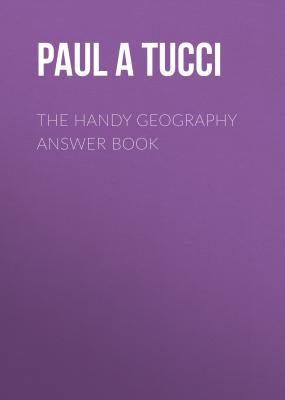The Handy Geography Answer Book. Paul A Tucci
Чтение книги онлайн.
Читать онлайн книгу The Handy Geography Answer Book - Paul A Tucci страница 4
 Caribbean
Caribbean
SOUTH AMERICA
Physical Features and Resources
WESTERN EUROPE
RUSSIA AND EASTERN EUROPE
Russia and the Former Soviet States
ASIA
Japan and the Korean Peninsula
THE MIDDLE EAST
AFRICA
Physical Features and Resources
OCEANIA AND ANTARCTICA
COUNTRIES OF THE WORLD
FURTHER READING
GLOSSARY
I wish to thank the following people whose great efforts help create this book: proofreaders Larry Baker and Shoshana Hurwitz (who also indexed this book), page and cover designer Mary Claire Krzewinski, typesetter Marco DiVita. Also, thanks to Matthew Rosenberg, who created the original first edition of this book many years ago. I also wish to thank the Visible Ink Editor Kevin Hile and Visible Ink Publisher Roger Jänecke for making this book possible.
Thank you also to my family and friends who encouraged me for over one year to write this book.
Aamsse (Wikicommons): p. 190.
Amerikanisches Aussenministerium: p. 209.
Cavit (Wikicommons): p. 23.
CherryX (Wikicommons): p. 217.
CIA: p. 256.
Continentalis (Wikicommons): p. 154.
Glenmary Research Center: p. 177.
Hile, Kevin: p. 105.
Hosseini, Mahmoud: p. 269.
Kmusser (Wikicommons): p. 49.
Mareklug (Wikicommons): p. 167.
Maslowski, Wieslaw, at the U. S. Naval Postgraduate School, Monterey, California: p. 187.
Mutxamel (Wikicommons): p. 215.
NASA: pp. 45, 75, 245.
National Archives and Records Administration: p. 90.
National Maritime Museum: p. 289.
National Park Service: p. 185.
NOAA: p. 93.
Shutterstock: pp. 4, 7, 9, 14, 21, 25, 27, 29, 31, 37, 38, 41, 44, 51, 54, 57, 58, 61, 64, 67, 69, 73, 78, 81, 86, 88, 97, 99, 108, 113, 116, 120, 133, 138, 143, 146, 148, 151, 157, 164, 171, 173, 175, 197, 199, 203, 212, 220, 223, 225, 228, 230, 234, 235, 238, 239, 242, 250, 252, 261, 265, 267, 270, 275, 280, 282, 284, 294, 296.
United Nations: p. 128.
U.S. Census: p. 130.
U.S. Geologic Survey: pp. 3, 36.
Public domain: pp. 10, 12, 17, 107, 136, 159, 161, 180, 192, 202, 246, 278, 289, 293.
What is so surprising about geography is how dynamic our world is and how it changes so quickly. It is profound to see just how much of the information contained within the previous edition has changed in just a few short years. Immutable facts of history are being challenged every day by scholars around the world. New artifacts are being discovered, and new interpretations of old texts are constantly being published. Technological advances have made measuring many things much more accurate and precise. We are now better able to see our world with greater clarity. Simultaneously, the enormous convergence of technology like software apps and powerful mobile devices, as well as the ubiquitous qualities of information in all its forms and formats, has brought access to geography and nearly all of its facets to billions of people. This is in sharp contrast to a much different world 500 years ago, when many people were convinced that the world is flat with edges not too far beyond the next pasture or village.
Things